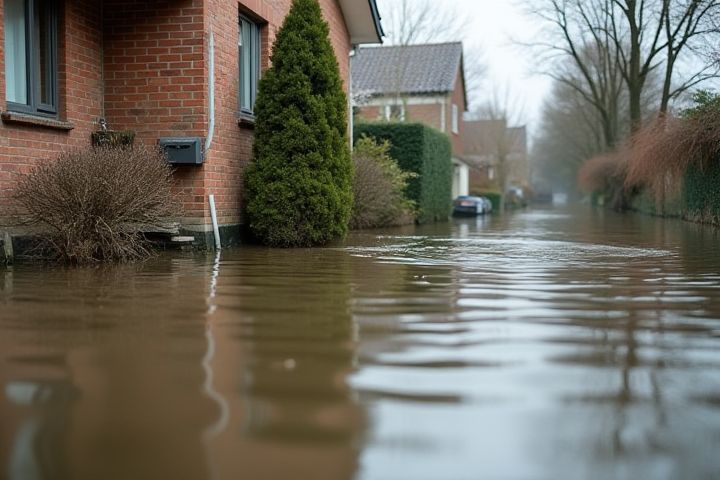
To protect your house from flooding, consider installing a sump pump system in your basement to effectively remove excess water. Elevating your home on piers or stilts can significantly reduce the risk of water damage during heavy rain or flash floods. Landscape your yard with native plants and strategic grading to direct water away from the foundation. Creating a rain garden can also absorb excess runoff, improving drainage around your property. Finally, ensure that gutters and downspouts are clean and directed away from your home to prevent water pooling near the foundation.
How To Protect A House From Flooding
Elevate utilities and appliances
Elevating utilities and appliances is crucial for protecting your home from flooding, especially in flood-prone areas. Elevate your electrical panels, water heaters, and HVAC systems at least 12 inches above the expected flood level to prevent water damage. Consider using platforms or piers that comply with local building codes to ensure structural integrity. This proactive measure can significantly reduce repair costs and safeguard your home's essential systems during a flood event.
Install sump pumps
Installing sump pumps is a crucial strategy for protecting your home from flooding, particularly in areas prone to heavy rainfall or rising water levels. A reliable sump pump can remove excess water from basements or crawl spaces, significantly reducing the risk of water damage and mold growth. When choosing a sump pump, look for models with at least a 1/3 horsepower motor and a backup power source to ensure functionality during power outages. Regular maintenance, including yearly check-ups and testing, can enhance the pump's efficiency, providing peace of mind during storm season.
Use flood barriers or sandbags
Installing flood barriers and sandbags can significantly reduce the risk of water damage to your home. Flood barriers, which can be made from robust materials like metal or plastic, are designed to divert water away from vulnerable areas of your property. Sandbags, typically filled with sand or soil, should be stacked around doors and other entry points, with at least 20-30 bags required for an average-sized home to create an effective barrier. Remember to check local regulations and flood forecasts to ensure the best placement and timely preparation of these flood protection measures.
Regularly clean gutters and drains
Regularly cleaning gutters and drains is essential in protecting your house from flooding. Clogged gutters can lead to water overflow, which may erode your foundation and cause water to seep into your basement or crawl space. Ensure that downspouts direct water at least five to ten feet away from your home's foundation to effectively divert rainwater. By maintaining clear gutters and drains, you significantly reduce the risk of water damage and maintain the integrity of your property.
Waterproof basement walls
Waterproof basement walls are essential for flood protection, acting as a barrier against moisture intrusion. To effectively waterproof, consider applying a waterproofing sealant made from polymer or epoxy, which creates an impermeable layer. Installing drainage systems, such as a French drain or sump pump, can direct excess water away from the foundation and complement the waterproofing efforts. Regularly inspect and maintain gutters and downspouts to ensure they channel water away from your home, thereby safeguarding your basement against potential flooding.
Design landscaping for water diversion
Designing your landscaping effectively can significantly reduce the risk of flooding around your home. Incorporate features like rain gardens that absorb excess rainwater and divert it from the foundation, using native plants that can thrive in wet conditions. Install swales, which are shallow, grass-lined ditches designed to channel water away from your property, ensuring that heavy rainfall is directed toward drainage areas. Additionally, using permeable paving materials in driveways and pathways can help water infiltrate the ground rather than pooling and causing flooding.
Raise electrical outlets
Raising electrical outlets is essential in flood-prone areas to minimize water damage and reduce electrocution risks. Electrical outlets should be elevated at least 12 inches above the potential flood level, complying with local building codes. Consider using weatherproof covers and waterproof enclosures to further safeguard your outlets against water intrusion. Implementing these measures can significantly enhance your home's resilience against flooding and ensure safety during extreme weather events.
Seal cracks and openings
To effectively protect your house from flooding, sealing cracks and openings is crucial. Start by inspecting your foundation, walls, and basement for visible cracks, utilizing a high-quality waterproof sealant to fill any gaps. Pay attention to entry points such as windows and doors; weather stripping can prevent water infiltration during heavy rainfall. Regular maintenance and reapplication of sealants can significantly enhance your home's flood resilience, ensuring your living space remains dry and secure.
Install backflow valves
Installing backflow valves is a critical measure to protect your home from flooding, particularly in areas prone to heavy rainfall or rising water levels. These devices prevent water from flowing back into your house through sewer lines during flooding or heavy storms, effectively reducing the risk of water damage. You should place backflow valves in key areas such as basement drains and sewer connections to ensure maximum protection. Regular maintenance and inspections of these valves are essential to keep them functioning properly, providing you with peace of mind during extreme weather events.
Elevate the foundation
Elevating the foundation of your house is a critical strategy to protect against flooding, particularly in flood-prone areas. This can involve raising the building on piers, columns, or a concrete slab at least one foot above the Base Flood Elevation (BFE) recommended by FEMA, which varies by location but often ranges from 2 to 12 feet above high tide levels. You may also consider using flood vents in your foundation to allow water to flow through instead of accumulating and causing structural damage. Implementing these changes not only safeguards your home but can also reduce flood insurance premiums, enhancing the overall value of your property.
